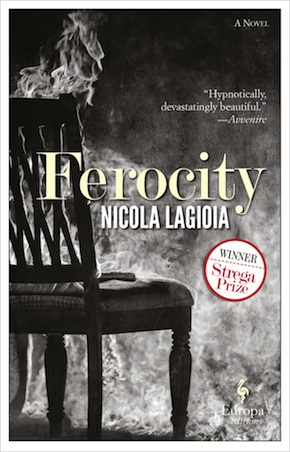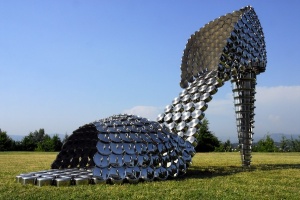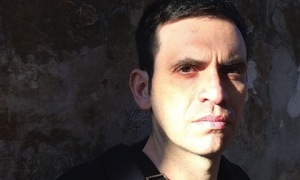Stilted life
by Mika Provata-Carlone
“Nicola Lagioia puts the boot into modern Italy.” The Spectator
Our times belong, in many ways, in an eerie brotherhood with moments in human history from almost half a millennium earlier: in our audacity, curiosity, enterprise, demographic explosion and multi-ethnic convergence, in the vibrancy (dark or light) of our questioning of what it means to be human, to belong to society, to progress and to aspire, in our very relationship to the real, we are perhaps drawn closer to the 17th and 18th centuries than to most other memorable historic timelines.
Our wealth and prosperity overwhelm and enchant us – while their extreme opposites cause us to doubt the substantiality of our glorious materialism. We are as puritanical as we are gregariously irregular, risqué, even aberrant. We claim a superhuman mastery over reality, science, morality, the limits of knowledge and the cosmos, at the same time that we seem to attribute the greatest powers to the preternatural, the paranormal, anything that would alleviate us from stark responsibility over our existence and the weight of common sense – and also the vital requirement of humility.
Our art, plastic or literary, visual or performative, is drawn towards not only naturalistic or figurative representation, but above all towards remonstration – towards highly stylised, most often disingenuous tableaux of vanitas, still-lifes that writhe with darkness but also dazzling, totally blinding light. We are fascinated by our own mortality – while doubting arrogantly, desperately, its inevitability; we belie the afterlife in the same breath that we proclaim our right to immortality and to an eternity of near-egomaniac confirmation. We possess all the material attributes to create the most cynical of still-life art statements (think Duchamp’s urinal) or the most elaborate, highly ambiguous, troubled and troubling compositions (Joana Vasconcelos, Marc Quinn, Cindy Wright, Ori Gerscht come to mind). From being primarily admonitory (memento mori, beware of mere materiality), vanitas for us (as in the later part of its peak moment in the 17th century) is an opportunity for irreverent, defiant, almost narcissistic displays of skill and of worldly attributes, for cosmic challenges into a duel between the human and what we no longer wish to call the divine, while still acknowledging it, grudgingly, as larger than our mere, resented, mortality. We relish conjoining with false modesty the demureness and spiritual undertones of the genre of still life with the boldness – and heretical pluck – of the gothic. The resulting picture of our reality and imagination is as much a reflection of genius, in its best form, as it is often shocking, an unsettling record of our precarious engagement with life, the depth of our vacuum, or, for many, of the liberating lightness of our postmodern insouciance.
Ferocity reads like a meticulously cinematic film-noir thriller, where the lustre of technique and the genuineness of inspiration fuse and are intended to collaborate.”
Nicola Lagioia’s Ferocity claims to belong to this counter-tradition of fiction as an anti-story, of narratives as transcending and transgressing the boundaries of authorship and readership, of perception, consciousness and plotline. His first novel, 2001’s Tre sistemi per sbarazzarsi di Tolstoj (senza risparmiare se stessi) ‘Three systematic ways to get rid of Tolstoy (without sparing oneself in the process)’ was a declaration of war against conventional meaning, structures, the givens of literary practice. It is a bold first step along a writing path claiming to bring the novel ‘back home’, to echo the title of another of his works. Rawness and the exposure of humanity in its starkest nakedness are Lagioia’s aims throughout his four novels so far, and his process of choice is slowness rather than speed: it takes time, he says, to “set alight my most explosive urgencies and my deepest needs. What I most desire to discover is what I most fear to bring to light. A writer’s profession has always seemed to me to be a middle way between the work of a scientist and an exorcist.” It is a way to deal with what he has called “private demons”, how to reconcile the technicalities of life with the emotional drama of a humanity in crisis.

Joana Vasconcelos: Carmen Miranda, 2008. Stainless steel pans and lids, concrete. Selfridges Art Collection, London joanavasconcelos.com
It is true that in Ferocity Lagioia has spared none of the elements of a certain type of high drama: Dynasty-type wealth and ambition, neo-realist analysis of social provenance and resulting ruthlessness and decadence, Studio 54 glamour and sinister fatality, with glimpses of economic crisis, social dissolution, and a landscape where the aspirations of property moguls clash with pioneering progress in cancer research, environmental concerns, the darkest objectification of women, and the most desperate trajectories of self-destruction in men.
Ferocity (a rather obvious semantic signifier, denouncing the feral viciousness of our urbanity) reads like a meticulously cinematic film-noir thriller, where the lustre of technique and the genuineness of inspiration fuse and are intended to collaborate. The natural underworld, the microcosm of insects, invertebrate and urban scavengers, is used explicitly and emphatically as a foil for human insignificance, angst and ultimately bestiality, in this densely woven tapestry of dark aestheticism, decadence and the ultimate inexorableness of existence. There is compulsive density of detail and of verbalised thought, of scenes employed to convey the highly intricate, burdened triviality of that side of illusory paradise. Decomposition in Lagioia’s hands becomes the artifice to convey very real social collapse, of a humanity “neurotically overwhelmed by narcissism.”
Ferocity is consumerism consumed, ambition as an uroboric monster turned upon itself. Lagioia’s novel aims to produce “a crescendo of increasingly sad perversions”, to be “open. Exhilarating. Useful. Friendly. Superficial. Pornographic. Bloody.” Within the fiction of the novel (but one suspects also in our experience as readers), our enthrallment with death and darkness, with the morbid and the obscene replaces meaningfulness and empathy, as though proximity to the macabre and the traumatic created an even greater distance from human reality.
The textile of connections, history and stories, of the symptoms and stigmata of our cosmopolitan virtual reality is highly elaborate in its details, highly condensed in the emotive impact it is intended to contain. It is a huge, vastly ambitious tableau, closer perhaps to the voyeuristic, prudish provocativeness of Watteau (cum neo-gothic twist) than the Calvinist severity of Brueghel in its depiction of decay, decline, degeneration, debasement and dejection or despair. There is quite often a sense of mannerist stagecraft, an awkward transparency of the authorial strategies, the calculations of plot flux and of emotive and narrative dynamics that leaves us anaesthetised rather than shocked by the viciously brutal material Lagioia has arraigned for us.
The plea for salvation – the salve mi of the family name at the centre of the novel, remains unfulfilled, unresponsive, an echo in a vacuum, if that were possible.”
Ferocity is lavishly louche and staggeringly macabre, pushing its brief with relentlessness and a dismissal of the limits of both truth and fiction. It is an incestuous flirtation with death and life, a highly polished attempt at a vanitas where the reminder of mortality is heavily hued by a sardonic self-indulgence in the ghoulish, in the exposé of affluence and of a life that is presented to us as epitomic of what lies beyond the mundane and ordinary. Ultimately, lamentably, the characters, for all their potential of horror, seem unable to exit stereotypes from a lesser reality and fiction. The explicit or hinted deviancy, instability and perversion, the emotional handicap pervading every layer and molecule of being, do not lead to a genuine sense of tragedy – there is no contrast, no loss, no lament or even failed atonement. The plea for salvation – the salve mi of the family name at the centre of the novel, remains unfulfilled, unresponsive, an echo in a vacuum, if that were possible. There is rawness that does not feel raw, even when it jolts the reader violently and viscerally; there is rich referencing of material culture and of American authors and artists; there is also the problematics of parallel planes of reality coexisting all at once. Yet the whole does not seem to hold up to its promise of catharsis, Armageddon or even exorcism. “Looking out the window, she saw the pool: it possessed the splendour of certain paintings form the school of American realism. Youth really was a paltry thing without a bundle of equity funds” we are told towards the end. “Now we are making stuff that did not even exist… All this produced cash” seems to sum up our relationship to being and nothingness. And perhaps ominously, the motto of it all, as a White Queen might say, is a final snippet of philosophical dialectics: “Do you know what scientific discipline best explains the new century?… Ethology. Animal behaviour.” “We are not animals,” one of the main characters objects. “We are strange things.”
Perhaps both statements have their modicum of truth. Even as our greatest virtue is the simplicity of our humanity, yet we insist on testing the limits of our id, the animal archetypes that we may or may not carry, our strangeness, which we proffer as a substitute to critical distance. Ferocity is of epic proportions, yet it relies for its effect, for its effectiveness, on such feet of clay: a strangeness that undermines the traumas it evokes, the ghosts it conjures up from the dead, the echoes of humanity it seeks to amplify.
 Nicola Lagioia is one of Italy’s most critically acclaimed contemporary novelists, and the recipient of the Volponi, Straniero, and Viareggio awards, in addition to the Strega. In 2010 he was named one of Italy’s best writers under forty. He has been a jury member of the Venice Film Festival and is the programme director of the Turin Book Fair and a contributor to Italy’s most prominent culture pages. He was born in Bari and lives in Rome. Ferocity is his English-language debut, translated by Antony Shugaar, out now in paperback from Europa Editions.
Nicola Lagioia is one of Italy’s most critically acclaimed contemporary novelists, and the recipient of the Volponi, Straniero, and Viareggio awards, in addition to the Strega. In 2010 he was named one of Italy’s best writers under forty. He has been a jury member of the Venice Film Festival and is the programme director of the Turin Book Fair and a contributor to Italy’s most prominent culture pages. He was born in Bari and lives in Rome. Ferocity is his English-language debut, translated by Antony Shugaar, out now in paperback from Europa Editions.
Read more
@NicolaLagioia
Antony Shugaar is a writer and translator from the Italian and the French. Among his recent translations are Walter Siti’s Resistance Is Futile (which won the Strega Prize in 2013), Viola Di Grado’s Hollow Heart, and the Nobel laureate Dario Fo’s The Pope’s Daughter. A contributing editor to Asymptote Journal, he has published articles in the New York Times, the Washington Post, the Boston Globe, and The New York Review of Books.
Mika Provata-Carlone is an independent scholar, translator, editor and illustrator, and a contributing editor to Bookanista. She has a doctorate from Princeton University and lives and works in London.

